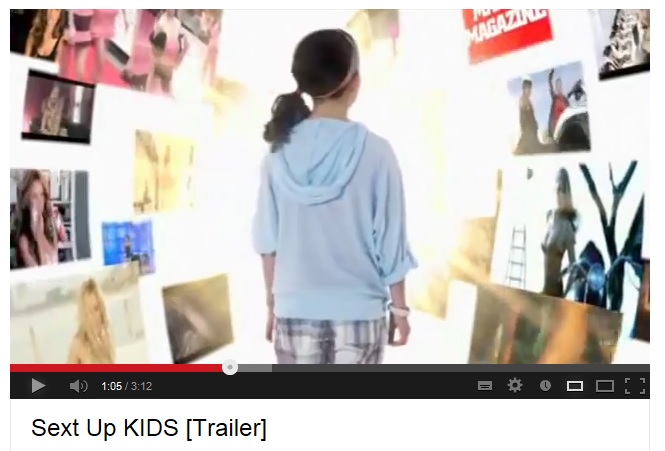“We are constantly amazed at the challenges girls are presented with today. When we were growing up things just didn’t seem as complicated. With the Internet and social media bringing sex and sexual content right into our homes, we have often wondered what the impact is on young girls and women today. The new feature documentary film, Sexy Baby, gives us an inside look into the new cultural shift taking a hold of America. Intimate, candid conversations and personal storytellingng expose this new reality. It is shocking and disturbing, but also a wake up call”.
(from http://www.womenyoushouldknow.net/sexy-baby-sexiness-the-c…/)
This is another brilliant (although a bit painful to watch I must admit…) 2012’s movie documentary from co-directors Jill Bauer and Ronna Gradus (the same directors of the recent Hot Girls Wanted), available in full format from You Tube.
After a powerful intro consisting of a fast-paced collage of images and clips cuts from popular media /news effectively depicting the sexual saturation of today’s mass media, the movie documentary starts with some young girls watching Lady Gaga in her sexually provoking “Poker Face” video while imitating her moves – a familiar sight for most people these days – then the camera filmed what appear as a 5-6 years old girl giggling “Britney Bitch”, mimicking the famous Will i Am ‘s song.
The documentary follow the lives of 3 women (one of them is actually still a young girl just becoming teenager): an ex porno-movies star who is trying to get pregnant, a 12 year old girl experimenting with her identity and a 22 year old who yearns for “normal” private parts.
What I’ve liked about this documentary is the non-judgemental way is filmed and the way it captures the reality of living in a media-saturated world. I would have loved to see more racial diversity in it, but that’s about it. The documentary is available now to watch in different formats and, considered its sexually-explicit nature, the authors have produced an edited educational version aimed to a younger audience for its screening into schools (which I’d be really keen to show to the girls taking part in my offline projects).
Sexy Baby is the first documentary film to put faces to a seismic cultural shift: the cyber age is creating a new sexual landscape. While doing research for the film, we had intimate and candid conversations with kids in middle school classrooms, suburban shopping malls, nightclubs, college dorms, and even conducted an informal roundtable during a high school house party. While chronicling trends among small town and big city kids, we discovered this: Having pubic hair is considered unattractive and “gross.” Most youngsters know someone who has emailed or texted a naked photo of themselves. Many kids have accidentally or intentionally had their first introduction to sex be via hardcore online porn. Facebook has created an arena where kids compete to be “liked” and constantly worry about what image to portray – much of what was once private is now made public. And the list goes on… –– (C) Sexy Baby Official Site
“We are the first generation to have what we have, so there is no one before us that can… kind of GUIDE US…I mean we are the PIONEERS” says Winnifred – a 12-year-old girl from New York.
What Winnifred says reflects the thinking of many other kids: they often feel that they live in a world which adults can’t understand fully. They are suspicious of our judgements and our perspective on things because after all we grown up in a completely different era, where computers, internet and social media were not around, so – in their view – how can we possibly guide them through this new sexual landscape? As parents and educators, perhaps we should ask ourselves: how much do we truly know about this new world and about our children’s world?

